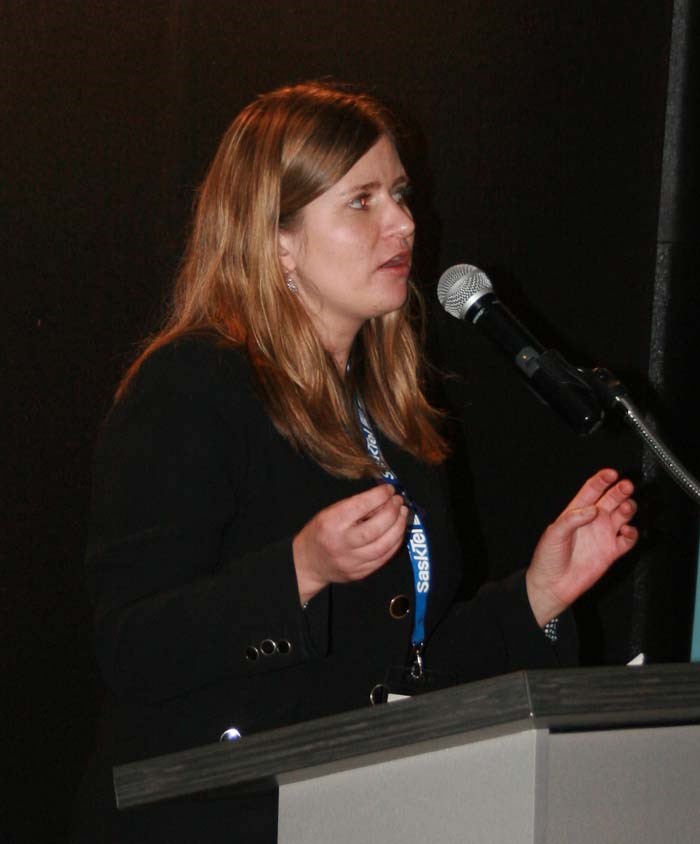Wetlands are important in terms of a watershed management system, but they may also be an economic resource.
At least that is the indication coming out of work by the International Institute for Sustainable Development (IISD).
Karla Zubrycki, communication manager with IISD, speaking at the Saskatchewan Association of Watersheds Conference in Yorkton said there is a growing recognition that there is a value to maintaining wetlands, and even some efforts to pay for wetland preservation. She pointed to ALUS (Alternative Land Use Services) as an example of a program that provides some compensation for saved natural environments, “recognizing services provided by farmers.”
Zubrycki added in other countries there have been efforts to recognize paying landowners for how they manage wetlands can be advantageous, such as how they manage water upstream from hydroelectric projects, paying for systems that aid the production system.
There is also a broader approach to creating a bio-economy, sustainable development must be built on three pillars, said Zubrycki; environmental, social, and economic.
A bio-economy is a system where the building blocks for industry and the raw materials for energy and high-value bio-products come from plants, she added.
Finding such options are important because as it is today many landowners are not big fans of wetlands.
“They’re challenging to manage. People wanted to drain them,” said Zubrycki.
Draining is not the best option however in terms of a natural water system.
“Wetlands are a critical part of a healthy wetland,” said Zubrycki, adding they mitigate flooding, and “effectively remove nutrients and toxins” in the water.
And in a number of situations wetlands tend to want to stay wetlands because of location.
“They just want to grow cattails,” said Zubrycki, adding they are at best marginal lands “which really only produce (a farm crop) in very dry years.”
So the idea of creating an economic reason for retaining wetlands was sought.
“It’s finding new uses for what’s on the landscape,” said Zubrycki.
One example of a possible way to generate a return on a wetland is turning cattails into energy.
Cattails are an important part of a wetland, with a wetland overall being a filter to clean water, as well as a storage area for water to help prevent flooding further down the line in a water system, reiterated Zubrycki. She noted the work dove-tailed well with concerns over the algae issues in Lake Winnipeg which have been linked to phosphorous in the water.
“Cattails take up a lot of phosphorous,” said Zubrycki, adding it was recognized “if we can control phosphorous upstream” it could help the water quality in the lake.
Continued on Page A11
Continued from Page A3
In terms of actual phosphorous cattails will take up to two kilograms per tonne of plant, and at the same time up to 10 kgs of nitrogen.
That might not sound like a lot, but Zubrycki noted in a 350-acre trial area some 5000 tonnes of cattail are produced annually.
“So it makes a significant difference in the nutrient loading in the watershed,” she said.
And the good news economically is that the cattails can be harvested in the fall, swathed and baled, and then turned into pellets which can be burned as an energy source.
One key aspect of the trial work is that the cattails can be harvested with conventional farm equipment in the fall once a wetland naturally dries.
“We burn it in pellet stoves,” said Zubrycki, adding as production ramps up there are applications to burn the pellets in institutional situations to create hot water heat.
While not producing the BTUs of coal “this is a cleaner fuel,” she said.
The pellets are finding a market, especially since Manitoba is phasing out coal generation on an institutional scale by 2017.
And the phosphorus that was initially purchased by a farmer for his crop, then captured by the cattails remains in the ash of the pellets. While the nutrient is not an easily plant accessible form in the ash, there is potential to eventually find a way to return it as a fertilizer too.
The use of cattails as a resource is not new. In Europe they have gone into things such as roof thatching, and China they are turned into pulp and paper, said Zubrycki, adding in Canada we are just beginning to explore the potential.




